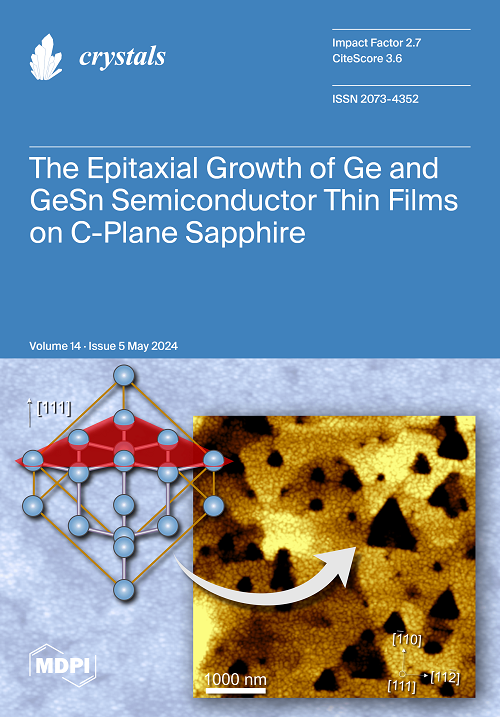Investigating the Formation of Different (NH4)2[M(H2O)5(NH3CH2CH2COO)]2[V10O28]·nH2O (M = CoII, NiII, ZnII, n = 4; M = CdII, MnII, n = 2) Crystallohydrates
IF 2.4
4区 材料科学
Q2 CRYSTALLOGRAPHY
引用次数: 0
Abstract
Three hybrid compounds based on decavanadates, i.e., (NH4)2[Co(H2O)5(β-HAla)]2[V10O28]·4H2O (1), (NH4)2[Ni(H2O)5(β-HAla)]2[V10O28]·4H2O (2), and (NH4)2[Cd(H2O)5(β-HAla)]2[V10O28]·2H2O (3), (where β-Hala = zwitterionic form of β-alanine) were prepared by reactions in mildly acidic conditions (pH ~ 4) at room temperature. These compounds crystallise in two structure types, both crystallising in monoclinic P21/n space group but with dissimilar cell packing, i.e., as tetrahydrates (1 and 2) and as a dihydrate (3). An influence of crystal radii and spin state of the central atom in [M(H2O)5(β-HAla)]2+ complex cations on the crystal packing leading to the formation of different crystallohydrate forms was investigated together with previously prepared (NH4)2[Zn(H2O)5(β-HAla)]2[V10O28]·4H2O (4) and (NH4)2[Mn(H2O)5(β-HAla)]2[V10O28]·2H2O (5) and spin states of [M(H2O)5(β-HAla)]2+ (M = Co2+, Ni2+, and Mn2+) cations in solution were confirmed by 1H-NMR paramagnetic effects. FT-IR and FT-Raman spectra for 1–5 are in agreement with the X-ray structure analysis results.研究不同 (NH4)2[M(H2O)5(NH3CH2CH2COO)]2[V10O28]-nH2O(M = CoII、NiII、ZnII,n = 4;M = CdII、MnII,n = 2)结晶水合物的形成过程
三种基于癸钒酸盐的混合化合物,即(NH4)2[Co(H2O)5(β-HAla)]2[V10O28]-4H2O (1)、(NH4)2[Ni(H2O)5(β-HAla)]2[V10O28]-4H2O (2)和 (NH4)2[Cd(H2O)5(β-HAla)]2[V10O28]-2H2O (3)、(其中 β-Hala = β-丙氨酸的齐聚物形式)是在室温、弱酸性条件下(pH ~ 4)通过反应制备的。这些化合物以两种结构类型结晶,均在单斜 P21/n 空间群中结晶,但具有不同的晶胞堆积,即四水合物(1 和 2)和二水合物(3)。我们研究了[M(H2O)5(β-HAla)]2+ 复合阳离子中中心原子的晶体半径和自旋态对晶体堆积的影响,这些影响导致了不同结晶水合物形式的形成,同时还研究了之前制备的 (NH4)2[Zn(H2O)5(β-HAla)HAla)]2[V10O28]-4H2O (4) 和 (NH4)2[Mn(H2O)5(β-HAla)]2[V10O28]-2H2O (5) 以及 [M(H2O)5(β-HAla)]2+ 的自旋态(M = Co2+、Ni2+和 Mn2+)阳离子在溶液中的自旋态由 1H-NMR 顺磁效应证实。1-5 的傅立叶变换红外光谱和傅立叶变换拉曼光谱与 X 射线结构分析结果一致。
本文章由计算机程序翻译,如有差异,请以英文原文为准。
求助全文
约1分钟内获得全文
求助全文
来源期刊

Crystals
CRYSTALLOGRAPHYMATERIALS SCIENCE, MULTIDIS-MATERIALS SCIENCE, MULTIDISCIPLINARY
CiteScore
4.20
自引率
11.10%
发文量
1527
审稿时长
16.12 days
期刊介绍:
Crystals (ISSN 2073-4352) is an open access journal that covers all aspects of crystalline material research. Crystals can act as a reference, and as a publication resource, to the community. It publishes reviews, regular research articles, and short communications. Our aim is to encourage scientists to publish their experimental and theoretical results in as much detail as possible. Therefore, there is no restriction on article length. Full experimental details must be provided to enable the results to be reproduced. Crystals provides a forum for the advancement of our understanding of the nucleation, growth, processing, and characterization of crystalline materials. Their mechanical, chemical, electronic, magnetic, and optical properties, and their diverse applications, are all considered to be of importance.
 求助内容:
求助内容: 应助结果提醒方式:
应助结果提醒方式:


